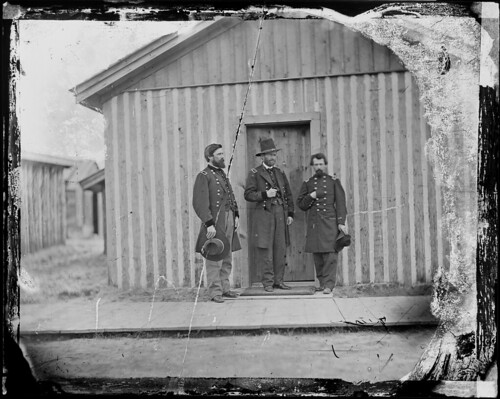 |
| John A. Rawlins on the left with General Ulysses S. Grant, and another member of Grant's staff on the right |
Why did I decide to start my post with John Rawlins? In my opinion, he is the most important, and interesting, general to come out of Galena. Rawlins was one of a few of the nine generals to be born in Galena, and the only one, other than Ulysses S. Grant, to hold a national office, he was Grant's Secretary of War.
John Rawlins was born on February 13, 1831 in Galena, Illinois. Rawlins was originally a lawyer in the town, he operated a law office with David Sheean, an influential Galena republican who will be discussed later in this blog. Rawlins was named city attorney of Galena in 1857 and served in that post until 1861, when the war broke out. In April 1861, Rawlins, standing in front of the JoDaviess County Court House delivered a rallying speech for volunteers, which caught the attention of Ulysses S. Grant.
When the war erupted Rawlins helped form the 45th Illinois, the Lead Mine, infantry regiment joining himself with the rank of major. Ulysses S. Grant, then a colonel, asked Rawlins to accept a commission as a 1st lieutenant in the regular army and become his aide-de-camp. On 30 August 1861 Rawlins was commissioned a captain and assigned as assistant adjutant on Brigadier General Grant's staff. As Grant moved up so did Rawlins. He was promoted to major on 14 May 1862, lieutenant colonel on 1 November 1862, and brigadier general of volunteers on 11 August 1863. Rawlins would run Grant's staff throughout the war, his duties ranging from issuing orders to by some accounts maintaining the commanding general's sobriety. Grant referred to him as the most nearly indispensable man he had around him. He was breveted major general of volunteers on 24 February 1865. On 3 March 1865 Rawlins was appointed brigadier general in the regular army and given the new title, created specifically for him, of Chief of Staff of the Army. This was the last appointment of brigadier general in the regular army made during the war. He was breveted major general in the regular army on 9 April 1865
Rawlins was noted many times for saving Grant's image during the war and hiding his vices from the public. Rawlins remained with Grant after the war as well, serving as Ulysses's Secretary of War from March to September of 1869. On September 6, 1869, Rawlins succumbed to tuberculosis and died while in office. His loyalty to Ulysses Grant showed even in his last days. His doctors recommended that Rawlins go to Arizona, where the dry desert climate would allow him to live longer. Rawlins refused, wishing to stay at Grant's side as his Secretary of War. He died in Washington and was buried in Congressional Cemetery, but his remains were later relocated to Arlington National Cemetery.
Rawlins is not well known by amateur civil war historians due to the small attention paid to him in Grant's memoirs. In his memoirs, written shortly before his death, Grant only mentioned Rawlins twice, and essentially ignored their professional and personal relationship. Surviving members of Grant's former staff were outraged at the fact that Grant would snub someone who had been as loyal to him—literally to the death—as Rawlins had been. The most likely explanation for this is given by historian E.B. Long, who wrote, "It might be that Grant did not wish to praise Rawlins too profusely because of the current reports picturing Rawlins as the protector of Grant from his own bad habits."
The life of General John A. Rawlins is one that is short, only 38 years, and not well known to many, but his loyalty to his General may have saved the Union, and that is why he is the first general I have touched upon on this blog.
 |
| The General John A. Rawlins statue in Washington D.C. is located at Rawlins Park. Rawlins township in JoDaviess County, Rawlins, Wyoming, and Rawlins County, Kansas are named in honor of him. |
John Aaron Rawlins is a fascinating character of our American Civil War. As a career lawyer, from September 1861 to April 1865 his entire knowledge of a soldier's life was on the job training with General Ulysses S. Grant. As Assistant Adjutant General and then Chief of Staff, Rawlins was a vital personality of the unyielding professional and personal leadership of the Army of the Tennessee. Four fused that army together and made it the undefeated success story it was in the field for four years: Major General Ulysses S. Grant, Brigadier General John Aaron Rawlins, Major General William T. Sherman and Major General James B. McPherson. The original "Fearsome Foursome."
ReplyDeleteBrandon, Do you know if there is a printed copy of JAR's 1861 rallying speech? My husband and I would very much like to read it. Thanks. Christine.
ReplyDeleteChristine,
DeleteThanks for the question. After doing some digging I was unable to find it online, however you may want to contact the history room at the Galena library and ask for Steve Repp he is a great source of Galena History, in my opinion the best. At the history room they have all the old newspapers from Galena and I am pretty sure it was published in a newspaper in 1861 so I would email or call him and see if you can get a copy sent to you.
Thanks
Brandon
John Aaron Rawlins is actually my great,great grandfather on my fathers side! I've read all about him and find him very interesting and I am very proud to have him as part of my family history. There is a town named Rawlins Wyoming and I have always wanted to go there! My father, who is now deceased has visited the town a few times and said there is a museum there dedicated to him!
ReplyDelete